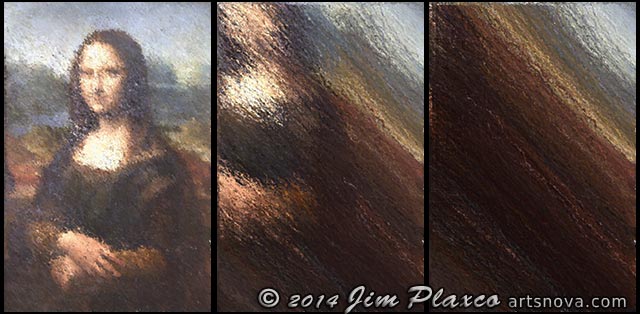Generative Art and the Mona Lisa Meme

Generative Art from the Mona Lisa
left to right: Generation 3922, 5826, and 8187
I want to share with you the results of a recent experiment of mine using a creative process known as generative art. Personally I find that the most interesting aspect of generative art is in being surprised by the artwork that a system produces. Generative systems can produce artistic outcomes not anticipated by the programmer/artist and the image above is one such example. On the left is an image of the Mona Lisa as it appears after 3,922 generations of the generative art program I wrote. On the far right is the same image after 8,187 generations.
What is Generative Art?
For the purposes of my discussion here I'll rely on an excerpt from the Wikipedia definition of generative art:
Generative art refers to art that in whole or in part has been created with the use of an autonomous system. An autonomous system in this context is generally one that is non-human and can independently determine features of an artwork that would otherwise require decisions made directly by the artist… Generative Art is often used to refer to computer generated artwork that is algorithmically determined.
Source: Wikipedia definition of Generative Art
Why are you picking on the Mona Lisa?
When testing out various programs that rely on the use of a source image for input it is quite useful to have a single standard image to use. That makes it much easier to compare the workings of different programs. An analogy is that of Playboy centerfold and Swedish model Lena Söderberg. Lena was the centerfold for the November 1972 issue of Playboy magazine. Her centerfold photograph was first used as a test image for image processing experiments in the summer of 1973 at the USC Signal and Image Processing Institute (SIPI). Subsequently this photograph became a standard source image for the testing of image processing algorithms. In explaining the decision for the use of this image, David C. Munson, editor-in-chief of IEEE Transactions on Image Processing, had this to say:
"First, the image contains a nice mixture of detail, flat regions, shading, and texture that do a good job of testing various image processing algorithms. It is a good test image! Second, the Lena image is a picture of an attractive woman. It is not surprising that the (mostly male) image processing research community gravitated toward an image that they found attractive."
My test image of choice is Leonardo da Vinci's painting Mona Lisa (La Gioconda in Italian). Because this painting is so well known and accessible, it makes it easier for people to "see" the results of an manipulation, distortion, or derivation of the original.
My Oscillating Generators
The generative art program that I wrote, which produced the illustrations at the head of this post, relies on a system of generators. You can think of each generator as simply being an independently functioning paintbrush.
In this particular run, I used 9200 generators (paintbrushes). Each generator (brush) has several characteristics: size, location, color, opacity, movement. In creating this system my idea was that each paintbrush would hover in the vicinity of its original location without straying too far. However, I did not provide a rule to enforce this behavior. Rather I left each brush free to go its own way.
To govern direction and speed I used a Perlin noise function that on the face of it was balanced. By balanced I mean that the system should have had no preferential direction. I was very much surprised at the results (shown above) from one of the several rule sets I had created.
For simplicity, each generator is unaware of the other generators in the system. For the next generation of this system, I plan on creating interacting generators. In such a system, when two generators encounter one another, they will react and/or interact. For example each could share with the other some or all of its characteristics. Each of these characteristics can be thought of as genetic material that can be shared.
So that you can better see the detailed progression of the system, I'm providing a large (1600 x 1600) image that shows the same subsection of the artwork as it progresses through generations. The leftmost section is from generation 3922, the middle section is from generation 5826, and the rightmost is from generation 8187.
Open image in new window – Generative Art Mona Lisa Triptych
For other examples of how the image of Mona Lisa has been used, check out the Processing artwork tagged with Mona Lisa at OpenProcessing.org
| Return to the Blog Index | This entry was posted on Friday, March 28th, 2014 at 12:01 pm and is filed under Algorithmic Art, computer art, Digital Art, Generative Art, New Media Art, Processing.